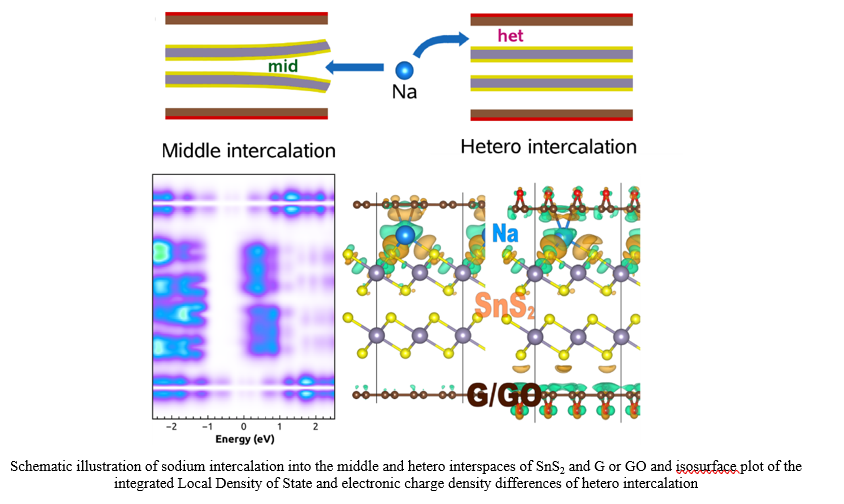Video Article Open Access
Two-Dimensional Hybrid of SnS2 with Graphene and Graphene Oxide for Improving Sodium Storage
Kum-Chol Ri*, Jin-Song Kim, Song-Hyok Choe
Computational Materials Design, Faculty of Materials Science, Kim Il Sung University, Pyongyang, PO Box 76, Democratic People’s Republic of Korea
Vid. Proc. Adv. Mater., Volume 3, Article ID 2208344 (2022)
DOI: 10.5185/vpoam.2022.08344
Publication Date (Web): 22 Dec 2022
Copyright © IAAM
Graphical Abstract

Abstract
High performance electrochemical energy storage devices is one of the most important challenges to mitigating some troubles of human life, such as fossil fuel, pollution, and climate change. As a ubiquitous energy storage technology with high energy and power densities, the rechargeable lithium-ion batteries (LIBs) plays the leading role for powering commercial electronic devices. Among the beyond lithium-ion battery, sodium-ion batteries (SIB) based on abundant and low-cost sodium resources have attracted remarkable attention in the spectrum of large-scale rechargeable battery system application for electric vehicles, back up energy storage, renewable energy such as solar and wind power. While many studies of energy storage materials offer good performances of today's state-of-the-art LIB/SIBs, inorganic two-dimensional (2D) materials is one of the most interesting appointment. Among 2D materials, graphene and its derivatives such as GO or rGO, which can be obtained by exfoliation from graphite, have been studied extensively, confirming the doubled capacity compared with graphite, very high surface area (2680 m2/g), high electron conductivity and excellent chemical stability. However, both Li and Na bind very weakly to the pristine graphene or GO, resulting in Li/Na clustering and dendrite growth. Tin disulfide (SnS2) as the typical TMD is recognized as a promising anode material due to its high initial capacity, but the reversible alloying reaction was found to give a large capacity of sodium storage in the first cycle, but to be accompanied with a large volume expansion (e.g., 420% for the case of Na-Sn alloying), leading to a poor capacity after a few cycles. Designing hetero-layered architectures by coupling graphene or GO with TMD or TMO 2D materials has emerged as an effective strategy to enhance the Li/Na binding strength and reduce the volume change as well. In particular, the hybrid composites formed by coupling rGO and TMDs have been reported to show a good performance as anode materials for LIBs and SIBs. In this work, we make a modeling of hybrid SnS2/G and SnS2/GO composites, together with 2D bi-layered SnS2, for conducting comparative and systematic study by using first-principles calculations within the density functional theory (DFT). Performing the structural optimizations, we analyze the detailed atomic structures of these 2D layered compounds, such as interlayer distance and bond lengths. The activation barriers for the in-plane atomic migrations of sodium atom are calculated in these composite systems of SnS2/G and SnS2/GO, and in the SnS2 bilayer. The local density of states (LDOS) and electronic charge density differences are analyzed. Based on the calculation data, we reveal the crucial role of hetero-interface behind the Na-storage enhancement of SnS2/GO hybrid.
Keywords
Sodium-ion battery; 2D material; hybrid composite; graphene oxide; tin disulfide.
Acknowledgement
The work was supported as part of the basic research project “Design of Innovative Functional Materials for Energy and Environmental Application” (no. 2016-20) by the State Commission of Science and Technology, DPR Korea. Computations have been done on the HP Blade System C7000 (HP BL460c) that is owned by Faculty of Materials Science, Kim Il Sung University.
References
- K.C. Ri, C.J. Yu, J.S, Kim, S.H, Choe, Inorganic Materials, 2019, 58, 1433-1441.
- G.C. Ri, C.J. Yu, J.S, Kim, S.N, Hong, U.G. Jong, M.H., Ri, Journal of Power Sources, 2016, 324, 758.
- C.J. Yu, U.S. Ri, G.C. Ri, J.S, Kim, Physical Chemistry and Chemical Physics, 2018, 20, 14124-14132.
Biography
Kum-Chol Ri is a lecturer of Faculty of Materials Science at Kim Il Sung University. He has got his Ph.D. degree in materials science from Kim Il Sung University in 2019. His research interest includes a computational materials design of energy materials such as electrode materials and sodium-ion conducting materials for sodium-ion batteries by applying first-principles method. He has published over 20 papers in peer-reviewed international journals including Inorganic Chemistry, Physical Review Applied and Journal of Power Sources. He attended the international conference of “TYC 5th Energy Workshop: From Atoms to Applications”, London, UK in 2018.
Video Proceedings of Advanced Materials

Upcoming Congress



